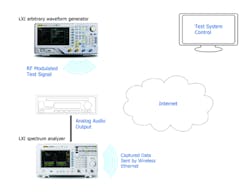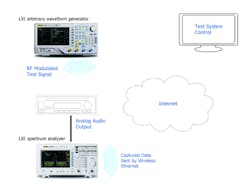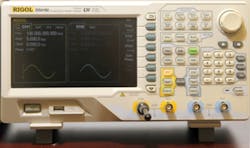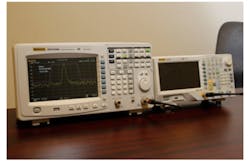Frequency modulation (FM) radio is still one of the most commonly used components of entertainment systems in today’s automobiles and plays an important role in overall automotive consumer ratings and satisfaction.
Advances in technology have introduced new forms of multimedia entertainment and various other forms of electronics in automobiles, enriching the consumer experience while at the same time creating new test challenges for car radio manufacturers. As entertainment systems and overall in-vehicle electronics become more complex, they introduce additional sources of noise interference and affect the quality of received FM signals.
By their very nature, automobiles prove to be difficult environments for FM radio performance testing. The test environment varies drastically from one automobile manufacturer to another and is highly dependent upon the vehicle’s location and operating conditions. For example, in an urban environment, the proximity of large buildings causes signal reflection and inhibits signal reception. FM receiver test systems must be flexible enough to account for the challenges introduced by FM radio use in automobiles.
LAN eXtensions for Instrumentation (LXI) is the standard for Ethernet control of instrumentation. Test engineers can communicate with and control LXI test instruments from anywhere in the world via a standardized web interface. For that reason, LXI is ideal for use in automotive FM receiver test systems where demodulated signals can be sent via Ethernet for analysis by test engineers working remotely.
Signal Generation and Analysis
In production testing, an arbitrary waveform generator (AWG) is used to provide the required RF test signal. The signal is demodulated by the FM receiver, and a spectrum analyzer is used to capture and analyze the results.
For testing FM receivers, audio test signals are modulated to a worldwide standard broadcast frequency from 87.5 MHz to 108 MHz, but the base frequency for each station always ends in 0.1, 0.3, 0.5, 0.7, or 0.9.
Although a bandwidth of 20 kHz or 30 kHz is all that is needed to transmit a narrowband FM signal, in the United States, FM channels are spaced 200 kHz apart to reduce signal interference and improve the signal-to-noise ratio (SNR). The 200-kHz frequency between each station provides 100 kHz of bandwidth on either side of the center frequency for its frequency modulation. However, a deviation of 75 kHz about the center frequency typically is used to allow for a margin of error and prevent adjacent stations from interfering with one another.
Test Setup
Figure 1 illustrates a typical FM receiver setup used to test car radios during production. The test setup includes Rigol Technologies’ DG4000 Series LXI AWG to simulate RF test signals and the DSA-1030A spectrum analyzer for signal capture.
Figure 1. FM Stereo Receiver LXI-Based Test System
In this example, the AWG is used to create a carrier sine wave at 100.00 MHz. Note that it may be necessary to change the carrier frequency by a few increments of 100 kHz if there is interference from local radio stations. An audio input signal will be used to modulate the carrier frequency by a specified deviation of 150 kHz (Figure 2).
Figure 2. RF Test Signal Simulation Using Rigol’s DG4000 Series LXI AWG
The center frequency of the DSA is set to the carrier frequency of the AWG or 100.00 MHz in this example (Figure 3). The FM signal will be transmitted from the output of the generator through an antenna and demodulated by the DUT, in this case the FM receiver of the car radio, then fed into the input of the spectrum analyzer where it will be displayed and analyzed. The quality of the receiver can be determined by comparing the input and output spectra of the signal.
Figure 3. Demodulated FM Signal at 100-MHz Carrier Frequency on Rigol’s DSA-1030A Spectrum Analyzer
Summary
An LXI-based FM receiver test system composed of an AWG to create RF test signals and a spectrum analyzer to capture and analyze the received signal provides an optimal test solution for both production testing and in-vehicle integration testing of car radios. LXI’s remote-access capabilities enable test engineers to control the instrument from anywhere in the world and provide real-time access to captured data from a standardized web interface. LXI instruments respond to the test challenges faced by car radio manufacturers brought by the continuous advancement of new technologies.
About the Author
Xing Fei is vice president of marketing and overseas operations at Rigol Technologies and serves on the board of the LXI Consortium. Prior to joining Rigol, Xing Fei held various sales and marketing positions at Hewlett-Packard TMO. He received an E.E. degree from Beijing Jiaotong University and is a senior member of the Chinese Institute of Electronics. [email protected]



